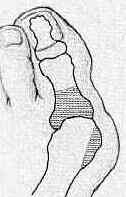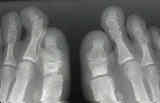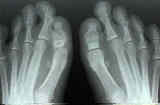- Discussion:
- procedure combines soft tissue release and removal of the medial eminence with resection of the proximal end of the proximal phalanx;
- complications include transfer metatarsalgia (helped with MP bar), recurrence (reduced w/ medullary pin and splinting), hallux varus,
and hallux extensus (minmized with use of IM pin);
- Indications:
- for the patient with an advanced hallux valgus or hallux rigidus deformity w/ significant arthrosis, and who does not place great deal of functional demand on the foot;
- results are probably best in patients with hallux rigidus, since the toe is less likely to become unstable;
- for housebound ambulator who wishes to increase level of activity but are prevented from doing so becasue of the severity of the deformity
or because of an inability to wear shoes;
- for recalcitrant non healing ulcers of the IP joint of great toe, by decompressing the toe and allowing more extension at the MP joint;
- Contra-indications:
- this procedure results in loss of stability of the 1st MT joint (and loss of the Windlass mech) and therefore should not be performed in young active individuals;
- contraindicated in patients with short first metatarsals or metatarsalgia, or in patients with an excessively long 2nd metatarsal;
- Technique:
- thru medial approach skin, subQ tissue, and joint capsule are opened;
- capsular tissue is then stripped from base of proximal phalanx of the great toe and of the MT head;
- medial eminence is excised in line w/ medial aspect of metatarsal shaft;
- proximal 1/3 of the proximal phalanx is excised;
- it is essential that the FHB attachment to the distal fragment is preserved;
- following osteotomy sharply dissect the periosteum and capsular tissues from the proximal fragment;
- note that resection of more than 50% of the proximal phalanx is a risk factor for a "cock up" dorsiflexion deformity, where as
resection of less than 33% of the proximal phalanx is associated w/ severe loss of motion;
- in order to avoid the "cock up" dorsiflexion deformity, consider suturing the flexor hallucis longus to the sesamoid pad, or by suturing
the sesamoid pad to the remaining proximal phalanx;
- draw in any redundant capsular and soft tissue structures into the joint w/ a purse string suture;
- alignment of joint is maintained by placing smooth 5/64 inch Steinmann pin across the MP joint;
- the bony surfaces must be help apart by the Steinman pin;
- pin is left in place for 4 weeks;
- Post Op:
- postop there may be tendency for drift into a dorsolateral direction;
- this tendency is due to inadequate soft tissue fixation to proximal phalanx;
- after the pin is removed, be sure to keep compressive dressings on the toe for 6 weeks to minimize the cock up deformity;
- because of instability of MP joint transfer lesion may occur beneath second metatarsal head
Arthrodesis of the first metatarsophalangeal joint as salvage for the failed Keller procedure.




